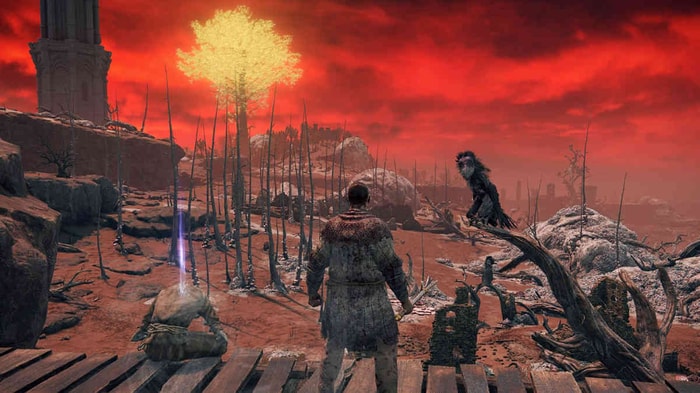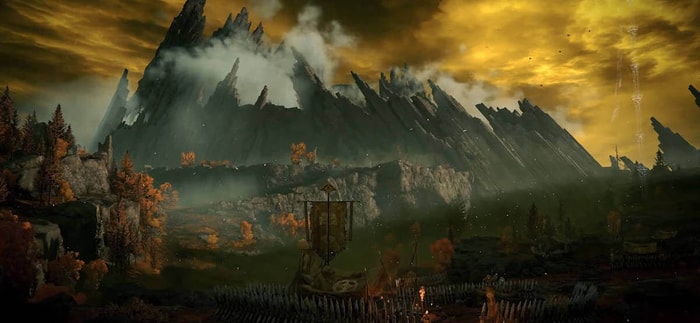Elden Ring is an ambitious and immersive dark fantasy adventure that offers players many possibilities to shape their journeys. It moves to an open-world format, which has been well-received by many critics and fans. It seems to be a good direction for FromSoftware's Souls-style games, as it allows for more gameplay exploration, freedom, and variety.
According to some reviews, Elden Ring sets a new benchmark for open-world design, as it combines the carefully crafted dungeons and bosses of previous games with a vast and dynamic overworld that contains many secrets and optional encounters.

The Open-World Format Details Are as Follows:
The game takes place in a vast and dynamic world, The Lands Between, which was created in collaboration with George R.R. Martin, author of A Song of Ice and Fire. It features a rich lore and history that players can discover through various means.
The world is divided into six regions, each ruled by a demigod who possesses a fragment of the shattered Elden Ring. These regions have their own landscapes, weather, wildlife, enemies, dungeons, ![]() bosses, secrets, and lore.
bosses, secrets, and lore.
The player can explore the world on foot or horseback, using fast travel points called Sights of Lost Grace to move between regions. The player can also summon their horse anytime, even mid-air.

The world is filled with various landmarks, structures, ruins, caves, castles, and catacombs that the player can discover and explore. Some locations are optional and may contain hidden Elden Ring items, ![]() treasures, NPCs, or bosses.
treasures, NPCs, or bosses.
The player has a lot of freedom and choice in how they approach the world and the main quest. They can tackle the regions and the demigods in any order they want or ignore them altogether. They can also interact with various factions, characters, and events that may affect the world and the story.
The game features a dynamic day-night cycle and weather system that may change the appearance and behavior of the world and its inhabitants. For example, some enemies may become more aggressive at night, or some paths may become inaccessible during a storm.

The game's combat is similar to Dark Souls but with some new elements and mechanics. The player can fight enemies with various weapons, spells, items, and skills. They can also use a new mechanic called Spirit Summons, spectral creatures that can assist the player in combat or exploration. The player can also use stealth to avoid or ambush enemies and use Elden Ring runes to enhance the character's capabilities .
The game supports online multiplayer for up to four players. The player can summon or be summoned by other players to cooperate or compete in the world. The player can also leave messages or specters for other players to see.
Future FromSoftware Games Should Double Down on Replay Value
Here are some details about the replay value:
Replay value is the extent to which a game can be played again after completing it once, either for enjoyment, challenge, or discovering new content.

FromSoftware's games are known for having high replay value, as they often feature multiple endings, branching paths, optional areas, and bosses, different builds and weapons, online multiplayer, and new game-plus modes that increase the difficulty and rewards of the game.
Elden Ring is the latest game from FromSoftware, and it has a lot of features that enhance its replay value, such as an open-world format that allows for more exploration and freedom, a dynamic day-night cycle, and a weather system that affects the world and its inhabitants, various factions, characters and events that may change depending on the player's actions, and a rich lore and history that can be uncovered through various means.
However, some players may feel that Elden Ring's replay value is lower than previous games, as it does not offer new items or questlines on each additional playthrough, and the open-world areas may feel less interesting or challenging after exploring them once. Some players may also prefer previous games' more linear and focused level design, such as Dark Souls 3 or Sekiro.
Future FromSoftware games should double down on replay value by adding more incentives and surprises for players who want to play the game again, such as exclusive items, skills, bosses, endings, or even areas that can only be accessed on higher difficulties or with certain conditions. They should also balance the open-world format with more intricate and varied-level designs that can offer different experiences each time.



